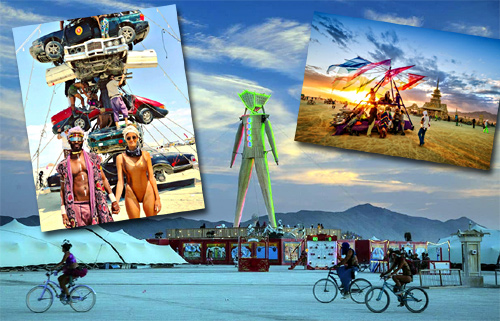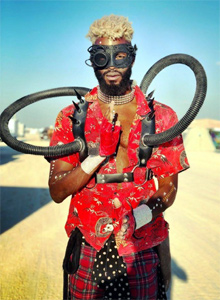 Well, if you missed it, you’ll have to wait til next year. The annual “Burning Man” festival was held in the Black Rock Desert of northwest Nevada last week. The images from this year’s event remind me of nothing so much as the Mad Max movies. The desert setting certainly contributes to the overall post-apocalyptic impression.
Well, if you missed it, you’ll have to wait til next year. The annual “Burning Man” festival was held in the Black Rock Desert of northwest Nevada last week. The images from this year’s event remind me of nothing so much as the Mad Max movies. The desert setting certainly contributes to the overall post-apocalyptic impression.
As evidence of its pagan roots, Burning Man was originally held in the month of June during the summer solstice. Organized more than 30 years ago as an experiment in community and art, the event has grown and evolved over the years – not necessarily for the better. This is from a sympathetic observer ~
What was once a genuinely radical festival, based on principles of inclusion, decommodification, self-reliance and communal effort, Burning Man festival has changed somewhat.
With your average person needing to shell out $1500 over the course of the festival, ‘escaping capitalism’ in order to rub shoulders with spaced out Silicon Valley brogrammers and pseudo-bohemian billionaires doesn’t come cheap.Source: BoredPanda
Alec M. Dent, writing at the Washington Free Beacon, offers a glimpse into the annual celebration of, well… whatever ~
The festival is known for many things—heavy drug use not least among them—like its themes of “radical inclusion,” the celebrities it attracts—noted miniature submarine enthusiast Elon Musk is a regular attendee […]
Like every religious gathering, Burning Man is full of ceremony and tradition. There is, for starters, a dress code. Burners see themselves as “the entertainment” for the week… and they are encouraged to dress as outlandishly as they can. Burning Man participants show up in things like suits of chainmail with oriental designs that reek of cultural appropriation or leather dominatrix outfits and pagan-looking, horned headdresses, if they wear anything at all […]
Vehicles, too, require a special panache for the festival—there are no cars, only “mutant vehicles.” They must be registered with Black Rock’s own DMV (Department of Mutant Vehicles).
Each year Burning Man features a temporary “temple,” though the object of one’s worship is purely a matter of personal preference. Dent describes the reconstruction of one such structure, found at the Renwick Gallery in Washington, D.C. ~
The temple is a place where Burners are encouraged to bring their troubles and pains. A sign in the Renwick informs visitors the temple is “always for one person.” It continues, “If you have lost someone dear to you, if you are suffering, if you need forgiveness, or shelter, or comfort, this Temple is for you.” It is meant to be a religious place, a sanctuary for the anguished, but it is stripped of all religious meaning. The altars there are impressive, but they are dedicated to no higher power.
How depressing that they’re looking for something they’ll never find at an escapist, fantasy festival in the desert. We all yearn for solace, comfort, fulfillment, deeper meaning than can be found in the grind of our daily lives. The only sure place to find all those things is the arms of a loving Savior – not at some self-indulgent, bizarre, nihilistic ritual.

The week-long gathering culminates in the symbolic ritual burning of a large 40 ft. wooden effigy. As Dent describes this “holiest of ceremonies” ~
(T)he burning of the Man is meant to represent “radical self-expression” according to Larry Harvey, one of the founders of the festival. It is their Eucharist, for just as Christians commune with their God through their ceremony, so too do the Burners. The difference is, of course, their god is the self.
‘Burning Man’ Is America’s Largest Religious Gathering ~ Michael Knowles describes the event as a bacchanal of sex, drugs, and pagan spirituality ~
Religious language pervades the entire festival. Burning Man founder Larry Harvey describes the event in terms ripped from the first chapter of the Book of Genesis. “This may be the essential genius of Burning Man,” he explains. “Out of nothing, we created everything.” Harvey laid out the festival’s Ten Principles in 2004, which include “radical inclusion,” “radical self-reliance,” “radical self-expression” — anyone notice a pattern? — as well as “gifting” and “decommodification.”
The exchange of money is prohibited at Burning Man, which costs between $390 and $1,200 per person to enter. Rounding out the list of principles are “participation” and “immediacy.” Harvey explains, “No idea can substitute for this experience.” Burning Man is not for Gnostics; it demands not just mind but body too.
The majority of attendees consider themselves “spiritual but not religious” ~
… which is code for the faddish modern paganism that admits metaphysical reality but refuses to be inconvenienced by it.
Sad. It’s just all so misguided, so contrived, and thus completely devoid of any real transcendent meaning.






Pingback: Saturday Shorts (late Sunday edition) – 4-20-19 | Designs on the Truth